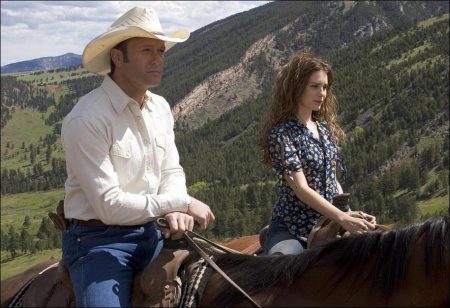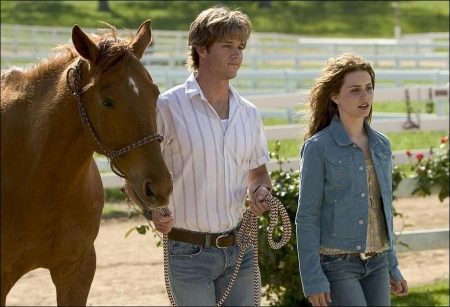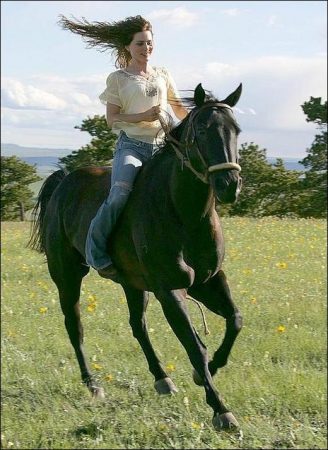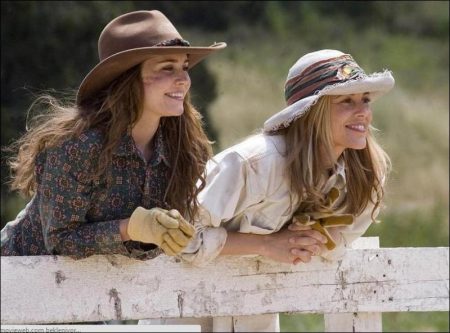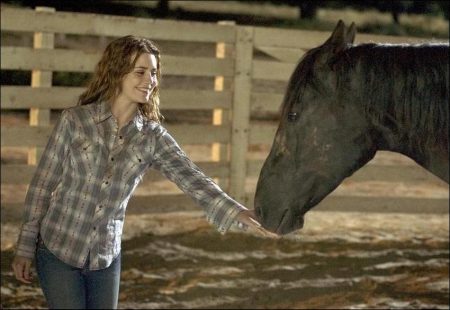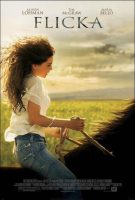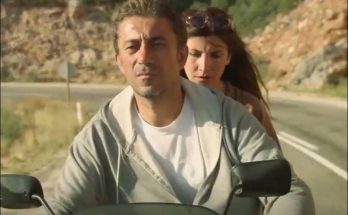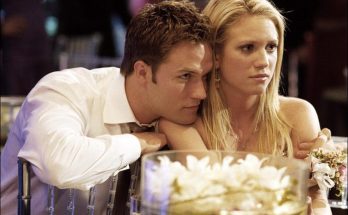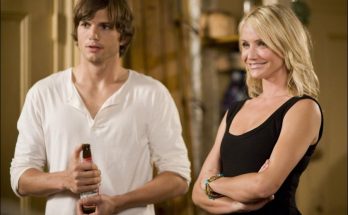Taglines: The biggest dreams take the most courage.
Based on the novel “My Friend Flicka” by Mary O’Hara, “Flicka” is set against the backdrop of a modern-day ranch in Wyoming. It tells the story of Katie (Alison Lohman), a teenager who dreams of running her family’s ranch, much to the dismay of her father (Tim McGraw); his hopes are pinned on her older brother. In the tale, Katie finds a wild horse she names Flicka and claims it for her own.
In Flicka, a contemporary motion picture adaptation of Mary O’Hara’s beloved novel My Friend Flicka, 16-year-old Katy McLaughlin (Alison Lohman) dreams of fulfilling her family legacy by working on her father’s ranch in modern-day Wyoming. But Katy’s father (Tim McGraw) wants more for her, insisting that Katy go to college. Katy finds a wild mustang, which she names Flicka, and sets out to make her a riding horse. But Flicka and Katy are more alike than she could have imagined. Like Katy, Flicka has a disdain for authority and is not about to give up her freedom without a fight.
The principal character in the book and in its two motion picture incarnations was an adolescent boy. But this new version tells the story through the eyes of headstrong Katy McLaughlin. Katy is enrolled in a private school on the outskirts of Laramie, Wyoming, but her heart is with her sprawling family ranch in the state’s remote mountain region. Katy returns home to the ranch, and soon becomes enamored of a wild mustang filly she finds in the mountain woods.
She names the long-legged, ebony horse Flicka, or “beautiful young girl,” in Swedish. But Katy’s rancher father, the equally-willful Rob, sees nothing but trouble coming from the untamed animal and discourages his daughter from keeping her. Nonetheless, conflicted by a need to harness her own wild ways yet stay true to a free spirit within, Katy sets out to break through to Flicka and transform her into a riding horse.
Despite her father’s disapproval, Katy goes on and forms an unbreakable bond with the wild horse. Her relationship with Flicka becomes a catalyst for change for the entire McLaughlin family, which is at a major crossroads: Katy’s dad is considering selling the ailing ranch, brother Howard (Ryan Kwanten) wants to leave Wyoming for college in Boston, and her mother Nell (Maria Bello) is fighting to keep her family from falling apart.
Can Katy ultimately tame her beloved Flicka and prove everyone wrong about the wild-hearted mustang? Will Rob find a way to support his daughter yet still keep her safe through this momentous life passage? And can the McLaughlins hold onto the ranch that they’ve worked so hard to maintain throughout a sea of social and economic change?
The journey back to the big screen for the enduring story of “My Friend Flicka” began with a new script by veteran screenwriters Mark Rosenthal & Lawrence Konner, who have collaborated in the past on such hit films as The Jewel of the Nile and Planet of the Apes.
Recalls Rosenthal, “When [Fox 2000 President] Elizabeth Gabler approached us about adapting ‘Flicka,’ we went straight back to the novel and decided to maintain its tone, which was deeply felt, but somewhat dark.” Rosenthal continues: “We found its themes even more significant today, as the American West, particularly Wyoming, has become a playground of second homes for the new super-wealthy.
“The story of an average, hard-working family eking out a living on the land and raising horses seemed to take on a whole new relevance in light of our country’s current economic climate,” Rosenthal elaborates.
It was Gabler who came up with the idea to make the story fresh and contemporary by turning the book’s main character, a teenage boy named Ken, into “Katy.” It was a brainstorm that challenged and inspired the writers. Says Rosenthal:
“This new twist gave Rob, the father, an exciting dilemma: What if the child that really understood the land and the ranch was the daughter, and not the son? This coupled with her headstrong personality and sometimes irresponsible ways generated a new way to look at the material.”
“Things pretty much flowed from the one central new idea,” explains Konner, “allowing us to create a father-daughter story where both characters had to learn something about themselves and each other. Each one had to re-examine their role within a revised family dynamic.”
The next step was attaching a director to the project, and the script was sent to Michael Mayer, who’d just directed his first feature, the well-received relationship drama A Home at the End of the World. Though Mayer, an acclaimed and highly successful Broadway theatre director, had no direct experience with horses or shooting action scenes, his grasp of storytelling and portraying human emotion made him an ideal candidate for the character-based FLICKA.
“I thought it was a really beautiful, universal story about the coming-to-terms of a father and daughter,” says Mayer. “It just so happens that a wild mustang is at the fulcrum of their relationship.
“What moved me most is how hard the family tries to make it all work. Everyone has the best intentions; there are no villains other than the vagaries of time and circumstance.”
With a completed script and a director on board, the cast for Flicka was then assembled. To play the pivotal role of determined young horse enthusiast Katy, the filmmakers zeroed in on the versatile Alison Lohman, who had impressed critics and audiences in such diverse films as White Oleander, Matchstick Men and Big Fish.
“Alison’s a great actress,” states the director. “Her performances have been amazingly soulful and truthful, with a depth that belies her years. I knew she could bring to Katy the exact combination of intelligence and emotional volatility.”
“I was instantly drawn to the character of Katy,” confirms Lohman. “I loved the fact that she’s not afraid to be opinionated. Even though she’s young, she stands her ground and knows what she wants. At the same time she’s also very soft and girly. I really liked that contradiction in her.”
The filmmakers then turned to music superstar – and rising actor – Tim McGraw to play Katy’s intractable, but deeply loving father, Rob. McGraw, who made an impressive acting debut in 2004’s hit football drama Friday Night Lights, welcomed the opportunity to play a more likable character. “Rob has his tougher moments, but he’s a good guy and solid family man,” says McGraw. “It was a great opportunity to do a movie that my kids – and kids for generations to come – could see and enjoy.
The filmmakers then turned to music superstar – and rising actor – Tim McGraw to play Katy’s intractable, but deeply loving father, Rob. McGraw, who made an impressive acting debut in 2004’s hit football drama Friday Night Lights, welcomed the opportunity to play a more likable character. “Rob has his tougher moments, but he’s a good guy and solid family man,” says McGraw. “It was a great opportunity to do a movie that my kids – and kids for generations to come – could see and enjoy.”
Family was also on McGraw’s mind when he produced the film’s soundtrack and wrote the original song “My Little Girl” with Tom Douglas, which McGraw performs as well. “The song has special meaning to me both for the film and being a father of three daughters,” says McGraw.
For Maria Bello, who was cast as Katy’s strong and centered mother Nell, FLICKA was a departure from her edgier film credits like Permanent Midnight, The Cooler and A History of Violence. “I don’t tend to be attracted to what could be considered ‘lighter’ material,” notes Bello, “but when I heard Michael Mayer was directing I realized I should pay attention. When I read the script, with its beautifully written relationships, I knew exactly why Michael was involved, and I knew I had to be too.”
Up-and-coming Australian actor Ryan Kwanten was next cast as Katy’s collegebound brother Howard. Dallas Roberts, who starred in the director’s A Home at the End of the World, was brought on as the McLaughlins’ reserved, long-time ranch hand Gus. Danny Pino was then selected to play the ranch’s other hand, the cocky heartthrob, Jack. Kaylee DeFer portrays Howard’s wealthy, horse-loving girlfriend Miranda.
Before filming began, the director and his cast had to become as familiar and fluid as possible with handling horses. Since, aside from Tim McGraw, the group had little or no experience with the animals, a “Cowboy Camp” was created where they were able to train with the film’s wranglers and learn everything they could about horses in a few short weeks.
The camp, led by head wrangler Rusty Hendrickson, introduced the actors to the horses they’d be riding, and established an overall comfort level with the animals.
“Whether it was teaching them how to twirl a rope, get on and off a horse properly, or any other related nuance, the goal was to make sure the actors would be able to sell it on film,” explains Hendrickson. Though everyone’s aptitude around horses was different, the wrangler maintains “sometimes it’s easier to teach someone who’s sponging in the information, than someone who already knows everything. They just hear more.”
As the actor who’d be spending the most screen time on or around horses, Alison Lohman had the most to learn. “You can’t act like you can ride – you can either ride or you can’t,” asserts Hendrickson. “So the first piece of business was getting Alison in the saddle. We had to bring her along fairly quickly, but we were all surprised and impressed with how well she did.”
Says Lohman: “With riding a horse, I think it’s just a matter of doing it, of just practicing and being with the horses, touching them, spending time with them. It was daunting and painful at first, but after weeks of training, it eventually started coming together. I was really proud of what I was able to accomplish in a relatively short time.”
Lohman wanted to connect with the horses emotionally. Recalls Hendrickson, “Alison wanted to know what a horse needs and what she should expect in return. She was as hard-working about the relationship as she was with the riding.
Maria Bello, who also had little experience with horses, approached her training from a different perspective. “I’d always been attracted to horses, but also sort of afraid of them,” she admits. “But after about my third lesson on Belle, the paint mare I ride, I suddenly understood what it meant to find your seat, to become one with the animal. It started to become a very Zen experience for me, this balance of control and surrender, which I look for often in my real daily life.”
It was a crash course for director Mayer as well, who spent a lot of time preparing with Rusty Hendrickson as well as with the second unit director. “We talked about what horses can really do and what they can’t do,” remembers Mayer. “One of the funniest moments was when I asked if we couldn’t make one of the horses ‘just look’ at Flicka.
The answer was ‘Michael, it’s a horse, not an actor.’ I quickly learned that horses aren’t performers, but rather really beautiful, intuitive animals. The last thing they were going to care about is where I want them to look when I yell ‘action!’”
Tim McGraw, on the other hand, grew up riding horses in his native Louisiana, but curtailed his riding once he moved to Nashville to pursue a music career. “It all came back to me once I started working with the wranglers,” affirms McGraw, “but I definitely had a lot of technical questions.”
McGraw was anxious to try new things, especially when it came to roping. To that end, the wranglers set up a dummy they pulled behind an all terrain vehicle for McGraw to chase and rope – on horseback. “I loved it,” enthuses McGraw. “I haven’t done any roping since I was a kid, and I could have practiced it all day long.” From a practical point of view, it also helped improve his riding skills. Notes head wrangler Hendrickson: “Roping gives you a specific goal and takes away some of the mental focus that can inhibit the actual riding.”
Strained backs and sore behinds aside, the actors all developed a great love and respect for the majestic animals. Says Tim McGraw: “When you’re around them, you are in awe of their power, their sensitivity, and just how athletic they are. It’s impossible not to form an incredible bond with them.”
“I think horses are the prototype for what is beautiful and free,” adds Alison Lohman. “When you are riding one, the connection is just so visceral and amazing.”
The horses needed training, too. Hendrickson worked with ten other wranglers, thirty head of ranch horses, ten additional cast horses, plus six different “Flickas” to prepare the animals for filming. According to Hendrickson, one of the hardest “movie tricks” to teach a horse is to hit their marks, especially without a rider. “It takes a lot of practice. You literally have to put their mark out on the ground and lead them to it over and over, until they finally get it,” he says. “Once they do, they’ll hit that mark each time – at liberty, of course.”
The wranglers were also involved in choosing the various horses that would alternate in the title role. They met with the filmmakers and, after agreeing on the exact color and description of Flicka, created a team of Flicka’s. “Before prep we didn’t know which horse would be good at what, but we knew all of the things we were going to try and attempt with them,” relates Hendrickson. “You just hope the horse that ultimately looks best in close-up is also as skilled and athletic as the others, and in this case, it worked out.”
Thanks to the extensive preparation, the actors and the horses worked together in perfect concert. There were, however, a few surprises along the way, including how “ready for their close-ups” the horses could actually be. Recalls Danny Pino, who plays Jack: “The horses we had on set were seasoned veterans. They’d be calm and very cool; then they’d hear ‘rolling’ and their ears would kinda prick up. Then they’d hear ‘speed’ and they’d start to get a little antsy. By the time Michael would yell ‘action,’ they’d be looking for their mark.
Adds director Mayer: “I eventually started to say ‘go’ around the horses instead of ‘action.’ And very quietly at that.”
To effectively shoot the most film’s most demanding set piece, a wild mustang race, Mayer knew the animals would have to be given very specific parameters. “The horses can be trained to go from, say, ‘A to B,’ explains the director, “so it became about constructing a whole series of ‘A to B’s’ for them and basically building the stampede on film.”
“It’s kind of like pouring water on the ground and estimating which way it’s going to run,” remarks Hendrickson. “You create a sanctuary for the horses, a place where they have food and water and no pressure, and they get to like that place. Then you take them away from this sanctuary and just let them go. Of course, they’ll want to go back there – and that’s what you end up filming.”
Though FLICKA is set in Wyoming, much of the movie was shot in the Los Angeles area, which also has its share of imposing mountains and pristine vistas. Says Muro: “We had to work around the city’s modern exteriors and look for the natural beauty that often goes unseen in contemporary Los Angeles. When you watch the film, it’s amazing to realize so many of these gorgeous, striking images were actually shot in L.A.
“We also wanted to challenge ourselves on the ‘reality vibe’ of this project. We wanted to avoid the typical, overlit ‘family look,’ which was ultimately consistent with film’s slighty darker, more unique approach to its classical subject matter.”
The filming of a scene depicting Katy’s dawn ride at the ranch was another tough assignment. “It was a hard scene to coordinate and compose,” states Muro. “It took a lot of extra planning and scheduling to pull off properly. Some of Katy’s horse ride to her mountain ridge home was shot in L.A., while other parts were filmed on location in Wyoming. The two locales meant shooting out of sequence. As we ended up filming day for night, as well as during actual dusk, we had to continually adjust our exposure to end up with uniform light and color throughout the entire scene. It was tricky, but it worked.
“I want audiences to feel so inspired by the beauty of this sequence,” adds Muro. “That they’ll want to go home, jump on a horse, and take the same kind of fantastic ride that Katy does.”
Lohman has her own hope for the audience – that the film will bring them back to nature and remind everyone that the country’s wide-open spaces needs to be preserved and honored. “It can’t all be tract homes and malls,” the actress declares. “We need to have some land left.”
“Each character in the film is kind of a paradigm of American individualism, each pursuing their own version of the American dream,” says director Mayer. “There’s something in the picture that speaks to all of us, because we know that you don’t get something for nothing in this land–the one that we created here.
“None of our characters go without making a really intense personal sacrifice, in one way or another. Yet, in the process, they all end up honoring each other as well, which I think is really beautiful.”
Alison Lohman Biography
Date of Birth: September 18, 1979
A native of Palm Springs, California, Alison Lohman always wanted to perform, despite her lack of family showbiz connections. She took acting and dance lessons, and by the age of nine, landed her first professional role playing the youngest daughter Gretl onstage in The Sound of Music at Palm Desert’s McCallum Theater. Two years later, she won the title role in the musical Annie and was awarded with the Desert Theater League’s award for Most Outstanding Actress in a Musical.
Presented with an award from the National Foundation for the Advancement of the Arts upon graduation from high school, Lohman was given a scholarship to the New York University School of the Arts, but decided instead to move to Los Angeles and begin her career. Her first jobs were guest appearances on the television series Pacific Blue and 7th Heaven.
Her feature film debut came in the forgettable alien flick Kraa! The Sea Monster (1998), and the following year, she appeared in no less than three features — The Thirteenth Floor, The Auteur Theory and The Million Dollar Kid — as well as a guest appearance on the television series Crusade, and a continuing role in four episodes of the show Safe Harbor.
In 2000 Lohman landed a regular role on the new television series Tucker, as well as the lead role in a TV movie called Sharing the Secret, in which she played a teenager suffering from anorexia. Later that year she landed a sizeable role in the feature Delivering Milo, alongside Albert Finney and Bridget Fonda.
The following year she appeared in Alex in Wonder (2001) as well as landing a recurring role as the teenage daughter on the TV series Pasadena. In 2002, she appeared in the forgettable White Boy, but also landed the plum role as Michelle Pfeiffer’s teenage daughter in White Oleander (2002). Lohman delivered a heart-wrenching performance as the young girl who sees her mother arrested for murder, then goes through a variety of foster homes while still being manipulated by her imprisoned mother. The movie was her break into the big leagues, and she moved on to her next role in Ridley Scott’s Matchstick Men (2003), starring opposite Nicolas Cage as a con artist’s teenage daughter.
A rider for a number of years, her horseback experience came in handy when she played a girl who loves horses in Flicka (2006), based on the classic novel by Mary O’Hara. Lohman lives in Los Angeles, but travels home often to visit her family in Palm Springs. Her hobbies include ballet and playing guitar.
Flicka (2006)
Directed by: Michael Mayer
Starring: Alison Lohman, Tim McGraw, Maria Bello, Ryan Kwanten, Katy McLaughlin, Dallas Roberts, Kaylee DeFer, Jeffrey Nordling, Dey Young, Buck Taylor, Wade Williams
Screenplay by: Larry Konner, Mark Rosenthal
Production Design by: Sharon Seymour
Cinematography by: James M. Muro
Film Editing by: Andrew Marcus
Costume Design by: Molly Maginnis
Set Decoration by: Maggie Martin
Art Direction by: Peter Borck
Music by: Aaron Zigman
MPAA Rating: PG for mild language.
Distributed by: 20th Century Fox
Release Date: October 20, 2006
Visits: 154
